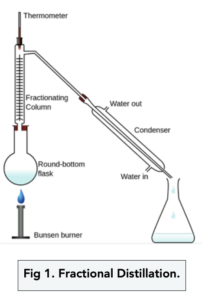Distillation (GCSE Chemistry)
Distillation
Distillation
Distillation is used to separate a solvent from a solution. For example, this process is used to obtain pure water from seawater.
- Set up the apparatus. The distillation apparatus involves a round-bottomed flask, a heat source, a thermometer, a condenser and a collecting beaker. We have to use a round-bottomed flask because it is less prone to cracking under heat.
- Heat the solution. The solution is heated and the liquid begins to evaporate. The vapour from the solution rises and then passes down the condenser, in which it is cooled and condensed using cold water.
- The liquid collects in the beaker. The cooling in the condenser turns the vapour into liquid again, and this liquid is collected in the beaker. The solute (e.g. salt from saltwater) is left in the round-bottomed flask.
Distillation works on the principle that the dissolved solute has a higher boiling point than the solvent.
Fractional Distillation
Fractional Distillation is used to separate individual liquids from a mixture of different liquids. These liquids dissolve in each other completely and are known as miscible liquids. Fractional distillation works on the principle that individual liquids in the mixture have different boiling points, starting with the liquid that has the lowest to the highest.
- Set up the apparatus. The mixture is placed in a flask with a fractionating column placed on top. The fractionating column is a long tube with lots of small glass beads. The column is hot near the bottom, and cooler near the top.
- Heat the mixture. The mixture is then heated and evaporates. The vapours rise through the column. The vapour condenses when it reaches a point in the column that has a temperature lower than its boiling point. Therefore the column separates liquids that condense at different temperatures.
- Liquid collects in the beaker. This liquid is then collected in a beaker, the first liquid to be collected will have the lowest boiling point.
Fractional distillation is used for separating ethanol from water and crude oil. We will look at this in more detail later on.

Distillation is a process used to separate liquids based on their boiling points. It involves heating a mixture of liquids to create vapor, which is then cooled and condensed to separate the liquids.
Distillation is used in chemistry to separate and purify liquids, such as alcohol from water or oil from water. It is a common technique in the production of chemicals, as well as in the purification of liquids for laboratory use.
Distillation works by heating a mixture of liquids to create vapor, which rises and is separated from the liquid. The vapor is then cooled and condensed, creating a separate liquid. The liquids are separated based on their boiling points, as each liquid will vaporize at a different temperature.
Distillation typically requires a distillation flask, a condenser, a thermometer, and a collection flask. The distillation flask contains the mixture of liquids, while the condenser is used to cool and condense the vapor. The thermometer is used to monitor the temperature of the mixture, and the collection flask is used to collect the separated liquids.
To set up a distillation apparatus, the distillation flask is placed on a heat source, such as a Bunsen burner. The condenser is connected to the flask, and the thermometer is inserted into the flask to monitor the temperature. The collection flask is also connected to the condenser to collect the separated liquids.
The efficiency of distillation is affected by the boiling points of the liquids, the temperature of the heat source, the efficiency of the condenser, and the size of the collection flask. It is important to carefully control these factors to ensure efficient and accurate separation of the liquids.
No, distillation cannot be used to separate all liquids. It is only effective for separating liquids with different boiling points. For liquids with similar boiling points, other techniques, such as chromatography, may be used instead.
Distillation can be dangerous if not performed correctly. The process involves heating flammable liquids, which can pose a fire risk. Additionally, the heated mixture can produce toxic or flammable vapors, which can be dangerous if inhaled. It is important to follow proper safety procedures and use appropriate protective equipment when performing distillation.
Distillation has a wide range of real-world applications, including the production of chemicals, the purification of drinking water, the production of alcohol, and the production of gasoline and other fuels. It is also used in the laboratory to purify liquids for use in experiments and analysis.





Still got a question? Leave a comment
Leave a comment